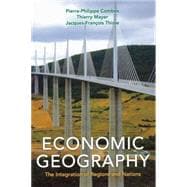
Note: Supplemental materials are not guaranteed with Rental or Used book purchases.
Purchase Benefits
Looking to rent a book? Rent Economic Geography [ISBN: 9780691139425] for the semester, quarter, and short term or search our site for other textbooks by Combes, Pierre-Philippe; Mayer, Thierry; Thisse, Jacques-Francois. Renting a textbook can save you up to 90% from the cost of buying.
| Foreword | p. xiii |
| Acknowledgments | p. xxiv |
| Facts and Theories | p. 1 |
| Spatial Inequalities: A Brief Historical Overview | p. 3 |
| The Space-Economy and the Industrial Revolution | p. 4 |
| Regional Disparities: When an Ancient Phenomenon Becomes Measurable | p. 12 |
| Concluding Remarks | p. 25 |
| Space in Economic Thought | p. 26 |
| Economics and Geography: A Puzzling History of Reciprocal Ignorance | p. 27 |
| Integrating Space in Economics: The Main Attempts | p. 30 |
| The Burden of Modeling Constraints | p. 31 |
| The Breakdown of the Competitive Paradigm in a Spatial Economy | p. 35 |
| What Are the Alternative Modeling Strategies? | p. 41 |
| Increasing Returns and Transport Costs: The Basic Trade-Off of Economic Geography | p. 43 |
| Concluding Remarks | p. 48 |
| Space, Trade, and Agglomeration | p. 51 |
| Monopolistic Competition | p. 53 |
| The Dixit-Stiglitz Approach | p. 55 |
| Monopolistic Competition: A Linear Setting | p. 71 |
| Concluding Remarks | p. 79 |
| Related Literature | p. 80 |
| Interregional Trade and Market Size | p. 81 |
| The Dixit-Stiglitz-Krugman Model of Trade | p. 82 |
| The Home-Market Effect | p. 89 |
| Concluding Remarks | p. 98 |
| Related Literature | p. 100 |
| Gravity and Trade Costs | p. 101 |
| The Gravity Model | p. 103 |
| Trade Costs | p. 115 |
| Concluding Remarks | p. 127 |
| Related Literature | p. 127 |
| The Core-Periphery Structure | p. 130 |
| Increasing Returns and Industrialization | p. 133 |
| Regional Disparities: The Krugman Model | p. 137 |
| The Krugman Model Revisited | p. 160 |
| Concluding Remarks | p. 162 |
| Related Literature | p. 164 |
| Intermediate Goods and the Evolution of Regional Disparities | p. 166 |
| The Role of Intermediate Goods | p. 169 |
| The Spatial Distribution of the Manufacturing Sector | p. 176 |
| The Evolution of Regional Disparities | p. 185 |
| Concluding Remarks | p. 191 |
| Related Literature | p. 192 |
| The Bell-Shaped Curve of Spatial Development | p. 194 |
| A Linear Core-Periphery Model | p. 196 |
| When Does the Bell-Shaped Curve Arise? | p. 207 |
| Concluding Remarks | p. 221 |
| Related Literature | p. 222 |
| Spatial Competition | p. 223 |
| Spatial Duopoly a la Hotelling | p. 224 |
| Spatial Oligopoly a la Cournot | p. 238 |
| Concluding Remarks | p. 250 |
| Related Literature | p. 251 |
| Breadth and Determinants of Spatial Concentration | p. 253 |
| Measuring Spatial Concentration | p. 255 |
| The Properties of an Ideal Index of Spatial Concentration | p. 256 |
| Spatial Concentration Indices | p. 259 |
| Indices Accounting for Industrial Concentration | p. 266 |
| The Duranton-Overman Continuous Approach | p. 269 |
| Concluding Remarks | p. 274 |
| Related Literature | p. 274 |
| Determinants of Spatial Concentration and Local Productivity | p. 276 |
| The Determinants of Spatial Concentration | p. 277 |
| The Determinants of Local Productivity | p. 283 |
| Concluding Remarks | p. 300 |
| Related Literature | p. 301 |
| The Empirics of Economic Geography | p. 302 |
| A General Framework | p. 303 |
| Location of Firms | p. 307 |
| Home-Market Effect | p. 314 |
| Factor Prices and Economic Geography | p. 321 |
| Migrations | p. 329 |
| The Stability of Spatial Patterns | p. 332 |
| Concluding Remarks | p. 340 |
| Related Literature | p. 342 |
| Theory with Numbers | p. 343 |
| Predictions Based on the Dixit-Stiglitz-Krugman Model | p. 345 |
| Simulations in an Estimated Model of the French Space-Economy | p. 356 |
| Concluding Remarks | p. 363 |
| Related Literature | p. 364 |
| Concluding Remarks | p. 365 |
| The Paradox of the Global Village | p. 365 |
| The Objective of Economic Geography | p. 367 |
| What Have We Learned? | p. 368 |
| Where Next? | p. 374 |
| References | p. 379 |
| Index | p. 397 |
| Table of Contents provided by Ingram. All Rights Reserved. |
The New copy of this book will include any supplemental materials advertised. Please check the title of the book to determine if it should include any access cards, study guides, lab manuals, CDs, etc.
The Used, Rental and eBook copies of this book are not guaranteed to include any supplemental materials. Typically, only the book itself is included. This is true even if the title states it includes any access cards, study guides, lab manuals, CDs, etc.